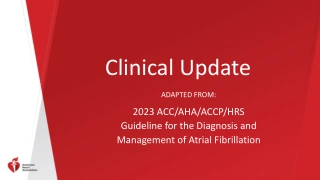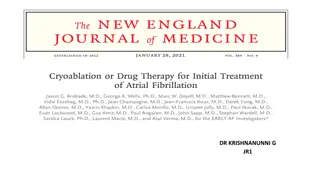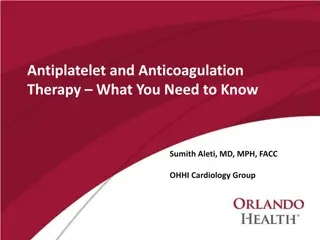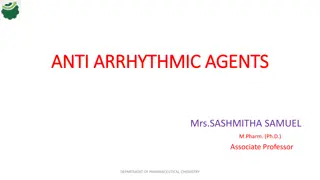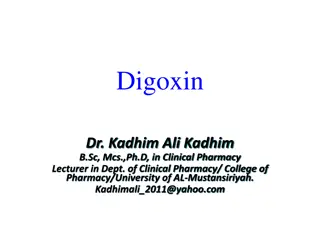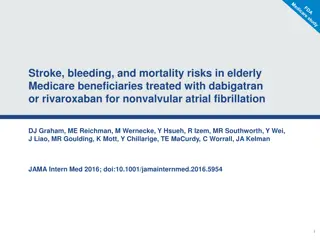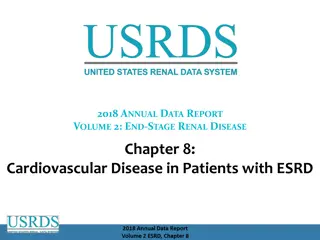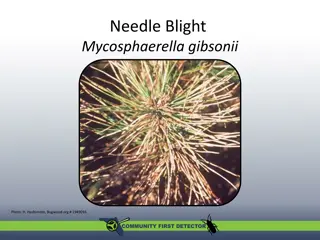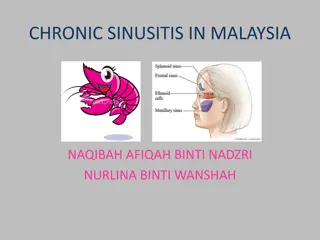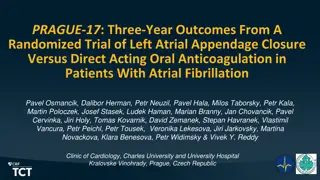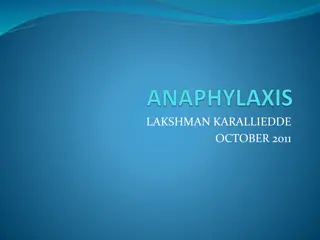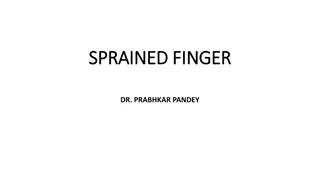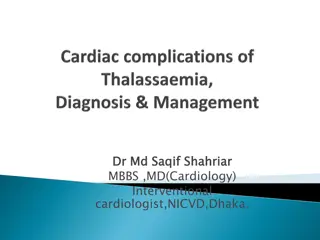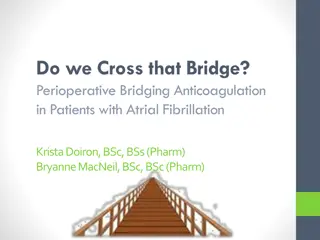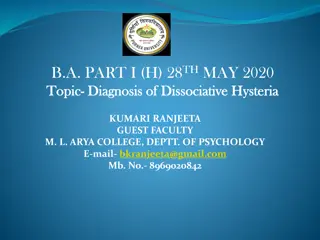Atrial Fibrillation Overview: Symptoms, Treatment, and Management
Heart Failure (HF) is increasingly recognized as a cause of Atrial Fibrillation (AF). The goals of individualized therapy for AF include ventricular rate control, restoration of sinus rhythm, maintenance of sinus rhythm, and prevention of stroke. Hemodynamically unstable AF requires emergent conversion to sinus rhythm, while stable AF patients with onset
Uploaded on Sep 27, 2024 | 3 Views
Download Presentation

Please find below an Image/Link to download the presentation.
The content on the website is provided AS IS for your information and personal use only. It may not be sold, licensed, or shared on other websites without obtaining consent from the author. Download presentation by click this link. If you encounter any issues during the download, it is possible that the publisher has removed the file from their server.
E N D
Presentation Transcript
ATRIALL FIBRILLITION Assist. Lec. Sura abbas Medicine ward
Introduction HF is increasingly recognized as a cause of AF; approximately 25% to 30% of patients with New York Heart Association (NYHA) class III HF have AF. and the arrhythmia is present in as many as 50% of patients with NYHA class IV HF.
Treatment Desired Outcomes The goals of individualized therapy for AF are: (a) ventricular rate control; (b) termination of AF and restoration of sinus rhythm (commonly referred to as cardioversion or conversion to sinus rhythm ); (c) maintenance of sinus rhythm, or reduction in the frequency of episodes of paroxysmal AF; (d) prevention of stroke and systemic thromboembolism. These goals of therapy do not necessarily apply to all patients; the specific goal(s) that apply depend on the patient s AF classification
Atrial Fibrillation (AF) or Flutter Recent Onset Hemodynamically Unstable AF For patients who present with an episode Hemodynamically unstable, emergent conversion to sinus rhythm is necessary using direct current cardioversion (DCC). Hemodynamic instability may be defined as the presence of any one of the following: (a) acutely altered mental status; (b) hypotension (systolic blood pressure less than 90 mm Hg) or other signs of shock; (c) ischemic chest discomfort; and/or (d) acute HF. of AF that is
If the patient is haemodynamically stable (no reduced conscious >90mmHg, no chest pain and no heart failure) and onset <48 hours, consider chemical cardioversionor DCC. level, systolic BP
Decision algorithm for conversion of hemodynamically stable atrial fibrillation to normal sinus rhythm
Chemical cardioversion Options include: Amiodarone IV 300mg infused over 1 hour then 900mg over 24 hours through a central line (preferable) or large peripheral line or Flecainide IV 2mg/kg, up to 150mg, over 30 minutes if no structural or coronary heart disease.
Decision algorithm for selecting drug therapy for ventricular rate control
Maintenance of Sinus Rhythm Decision algorithm for maintenance of sinus rhythm/reduction in the frequency of episodes of atrial fibrillation (AF) for patients with symptomatic paroxysmal or persistent AF despite rate control therapy
Maintenance of Sinus Rhythm Options include beta-blocker, sotalol, flecainide and amiodarone depending upon circumstances and patient factors Amiodarone loading regime is amiodarone oral 200mg three times daily for 1 week then 200mg twice daily for 1 week then 200mg daily.
Notes N.B. Ideally, check baseline thyroid and liver function tests before starting. Interactions include digoxin and simvastatin (see BNF Appendix 1 for more details). N.B. Deal with precipitants of AF: Infection, alcohol, hyperthyroidism, heart failure
Atrial Fibrillation (AF) Persistent Therapeutic Objectives: 1. Relieve symptoms often only rate control required; diuretic may also be needed (often only on temporary basis). 2. Target ventricular (apex or ECG) rate <110bpm. If still symptomatic, aim for lower rate, <80bpm. 3. Assess thromboembolic risk and anticoagulate as appropriate (see flow chart further on). 4. In some cases, consider restoration of sinus rhythm by electrical or pharmacological cardioversion (only attempt chemical or electrical cardioversion after warfarin; risk of thromboembolism if not anticoagulated; limited long-term success). 5. Treat concomitant LV systolic dysfunction / heart failure. adequate anticoagulation with
Ventricular rate control in persistent AF 1. Target ventricular (apex or ECG) rate <110bpm. If still symptomatic then aim for lower rate, <80bpm. 2. Patients without heart failure should be started on either: A beta-blocker choice includes: Bisoprolol oral 2.5mg daily and up-titrate to 5mg once daily if ventricular rate is still >110bpm or Atenolol oral 25mg twice daily and up-titrate to 50mg twice daily if ventricular rate is still >110bpm. In frail or elderly patients consider starting dose of atenolol oral 25mg once daily.
Or A rate-limiting calcium-channel blocker (CCB) i.e. verapamil or diltiazem (but avoid if LV systolic dysfunction)- Start with verapamil (slow release) oral 120mg once daily and titrate up to 240mg once daily if ventricular rate still >110bpm.
Digoxin has a limited role as first-line treatment for ventricular rate control. It can be used in combination with a beta-blocker / rate-limiting CCB when control of the ventricular rate is difficult. 3. Patients with heart failure should be started on digoxin and follow the NHSGGC Heart Failure guideline. Heart failure / LV Systolic Dysfunction ACE inhibitors recommended. Beta-blockers must be initiated under direction of a hospital physician. Rate-limiting CCBs should be avoided and beta-blockers are strongly
Prevention of stroke / thromboembolism Patients with both recurrent paroxysmal AF and sustained AF have a high risk of thromboembolism, particularly stroke. This risk is greatest in patients with certain risk factors. For primary prevention, anticoagulants can substantially reduce risk of thromboembolism. Patients with AF and a previous stroke or transient ischaemic attack (TIA) have an absolute risk of a further stroke of the order of 10 12% per annum and an absolute benefit of approximately 80 fewer strokes per 1000 patient years of treatment. Advanced age is not a contraindication to anticoagulation. In patients with 'lone' AF, i.e. AF in a structurally normal heart and no other risk factors for thromboembolic disease (CHA2DS2-VASC = 0), no anti-thrombotic or anticoagulant therapy is recommended.
Who should receive anticoagulant therapy Patients with clinical risk factors or echocardiographic risk factors Patients without contraindications to Anticoagulant therapy.
Cautions / contraindications to anticoagulant therapy Absolute contraindications include: active bleeding, pregnancy, stroke <14 days. Relative contraindications include: significant bleeding risk e.g. active peptic ulcer or recent head injury; bleeding in the last 6 months; previous cerebral hemorrhage. Cautions include: recurrent falls, alcohol abuse.
Choice of agent: new oral anticoagulant agents (NOACs) vs warfarin Pros of NOACs More stable anticoagulation No requirement for anticoagulant monitoring Fewer food and drug interactions Fewer intracranial bleeds Cons of NOACs No specific antidote More gastrointestinal bleeding with dabigatran and rivaroxaban, especially in the elderly Remember: NOACS are indicated only in those patients who have non-valvular AF; not those with mitral stenosis or a mechanical valve.
Combined anticoagulant and antiplatelet therapy Adding aspirin to warfarin in AF does not reduce the risk of stroke (except with prosthetic heart valves) but substantially increases the risk of bleeding. The combination is generally not indicated in stable coronary disease, but there are some circumstances, such as after an acute coronary event or PCI, when short-term combined double or triple therapy is used according to cardiologist advice.
Non-valvular Atrial fibrillation (paroxysmal, persistent or permanent)
New anticoagulants (direct thrombin and Factor Xa inhibitors) New anticoagulants: Apixaban oral 5mg twice daily Dabigatran oral 150mg twice daily Rivaroxaban oral 20mg once daily Doses may need to be reduced in some patients who have either low body weight ( 60kg), renal impairment or age 80 years and another risk factor.
Digoxin In frail elderly patient or patients with very low body weight, lower loading and maintenance doses than those advised below may be required. Loading dose normal renal function: Digoxin oral (preferred route) 500micrograms followed 6 hours later by 500 1000micrograms in divided doses > 6 hours apart or Digoxin IV 500micrograms followed 6 hours later by 250 500micrograms in divided doses 4 6 hours apart. Loading dose renal impairment (creatinine clearance <30ml/minute): Digoxin oral (preferred route) 500micrograms followed 6 hours later by 250 375micrograms in divided doses >6 hours apart or Digoxin IV 250 500micrograms N.B. Digoxin injection: 25micrograms = 0.1ml. Additional loading doses may be required; give according to ventricular (heart rate) response. Maintenance daily dose: The tables below outline digoxin daily maintenance dosing for patients <60kg (see table 2) and >60kg (see table 3).









